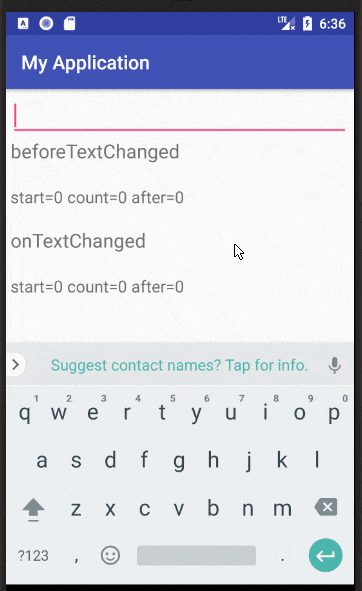beforeTextChanged和onTextChanged的参数起初有点难理解。观看以下示例演示几次可能会有帮助。请注意计数。
- 红色高亮显示的是即将被绿色文本替换的旧文本。
- 绿色高亮显示的是刚刚替换红色文本的新文本。

beforeTextChanged
start 是即将被删除的红色高亮文本的起始索引。count 是即将被删除的红色高亮文本的长度。after 是即将添加的绿色高亮文本的长度。
onTextChanged
start 是刚刚添加的绿色高亮文本的起始索引。这与beforeTextChanged中的start相同。before 是刚刚删除的红色高亮文本的长度。这与beforeTextChanged中的count相同。count 是刚刚添加的绿色高亮文本的长度。这与beforeTextChanged中的after相同。
afterTextChanged
editable 是来自EditText的可编辑文本。您可以在此更改它。这样做会再次触发所有TextWatcher事件。- 您没有任何关于更改内容的信息。如果您想知道,可以在
onTextChanged中设置一个span,然后在此处查找该span。
何时使用哪个?
如果您想观察到正在进行的更改,请使用
beforeTextChanged()或
onTextChanged()。但是,在这些方法中,您不允许更改
CharSequence文本。
如果您想在更改后进一步修改文本,请在
afterTextChanged()中进行。
代码
以下是代码,如果您想自己尝试玩耍。
MainActivity.java
public class MainActivity extends AppCompatActivity {
final static int RED_COLOR = Color.parseColor("#fb7373");
final static int GREEN_COLOR = Color.parseColor("#40de83");
@Override
protected void onCreate(Bundle savedInstanceState) {
super.onCreate(savedInstanceState);
setContentView(R.layout.activity_main);
EditText editText = findViewById(R.id.editText);
final TextView tvBeforeText = findViewById(R.id.tvBeforeText);
final TextView tvBeforeNumbers = findViewById(R.id.tvBeforeNumbers);
final TextView tvAfterText = findViewById(R.id.tvAfterText);
final TextView tvAfterNumbers = findViewById(R.id.tvAfterNumbers);
editText.addTextChangedListener(new TextWatcher() {
@Override
public void beforeTextChanged(CharSequence s, int start, int count, int after) {
SpannableString spannableString = new SpannableString(s);
BackgroundColorSpan backgroundSpan = new BackgroundColorSpan(RED_COLOR);
spannableString.setSpan(backgroundSpan, start, start + count, Spannable.SPAN_EXCLUSIVE_EXCLUSIVE);
tvBeforeText.setText(spannableString);
tvBeforeNumbers.setText("start=" + start + " count=" + count + " after=" + after);
}
@Override
public void onTextChanged(CharSequence s, int start, int before, int count) {
SpannableString spannableString = new SpannableString(s);
BackgroundColorSpan backgroundSpan = new BackgroundColorSpan(GREEN_COLOR);
spannableString.setSpan(backgroundSpan, start, start + count, Spannable.SPAN_EXCLUSIVE_EXCLUSIVE);
tvAfterText.setText(spannableString);
tvAfterNumbers.setText("start=" + start + " before=" + before + " count=" + count);
}
@Override
public void afterTextChanged(Editable s) {
Log.i("TAG", "afterTextChanged: " + s);
}
});
}
}
activity_main.xml
<?xml version="1.0" encoding="utf-8"?>
<LinearLayout
xmlns:android="http://schemas.android.com/apk/res/android"
android:orientation="vertical"
android:layout_width="match_parent"
android:layout_height="match_parent"
android:padding="5dp">
<EditText
android:id="@+id/editText"
android:layout_width="match_parent"
android:layout_height="wrap_content" />
<TextView
android:layout_width="wrap_content"
android:layout_height="wrap_content"
android:textSize="20sp"
android:text="beforeTextChanged" />
<TextView
android:id="@+id/tvBeforeText"
android:textSize="17sp"
android:layout_width="wrap_content"
android:layout_height="wrap_content" />
<TextView
android:id="@+id/tvBeforeNumbers"
android:textSize="17sp"
android:text="start=0 count=0 after=0"
android:layout_width="wrap_content"
android:layout_height="wrap_content" />
<TextView
android:layout_width="wrap_content"
android:layout_height="wrap_content"
android:textSize="20sp"
android:layout_marginTop="20dp"
android:text="onTextChanged" />
<TextView
android:id="@+id/tvAfterText"
android:textSize="17sp"
android:layout_width="wrap_content"
android:layout_height="wrap_content" />
<TextView
android:id="@+id/tvAfterNumbers"
android:textSize="17sp"
android:text="start=0 count=0 after=0"
android:layout_width="wrap_content"
android:layout_height="wrap_content" />
</LinearLayout>
